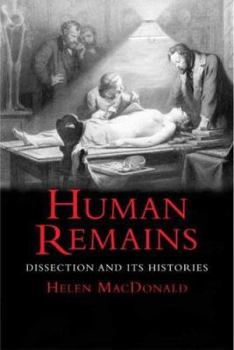Human Remains: Dissection and Its Histories
Select Format
Select Condition 
Book Overview
Until 1832, when an Act of Parliament began to regulate the use of bodies for anatomy in Britain, public dissection was regularly-and legally-carried out on the bodies of murderers, and a shortage of... This description may be from another edition of this product.
Format:Hardcover
Language:English
ISBN:0300116993
ISBN13:9780300116991
Release Date:December 2006
Publisher:Yale University Press
Length:220 Pages
Weight:1.20 lbs.
Dimensions:1.0" x 6.4" x 9.3"
Customer Reviews
3 ratings
Human Remains
Published by Thriftbooks.com User , 14 years ago
An excellently written book examining the intersections of colonial, indigenous and scientific history on the Australian frontier.
The dark side of the History of Medicine
Published by Thriftbooks.com User , 16 years ago
This book is a good account about a rather unknown and dark part of the History of Medicine : the History of Anatomy and Dissection based on the raging way for getting cadavers to dissect. Boddy snatching, grave robbing, burking... You will be dragged into the dregs of the Society and Ethics.
The Use, But Mostly Abuse, of Cadavers
Published by Thriftbooks.com User , 17 years ago
Just last week, the Natural History Museum in London agreed that it would return the bones and teeth of some seventeen natives of Tasmania. The specimens were collected in the nineteenth century, and will be repatriated, probably for burial or cremation, because the Tasmanian Aboriginal Center made a request for such a return. The museum's trustees agreed to the return, but the museum's scientists don't want to let go of their bones, as they were seen as important to the global scientific community. However, in Human Remains: Dissection and Its Histories (Yale University Press), Helen MacDonald has already shown that the insistence of keeping such specimens to advance the cause of science is disingenuous. Skulls and other bones residing in the British Museum, for instance, are "filthy with dust, and in a dark cellar", and the cataloguing is such that it is difficult even to determine the number of specimens. It is hard to say that such specimens are vital to science if this is how they are kept, but the current keepers are also keeping up a tradition of holding on to skeletons from distant regions as souvenirs. MacDonald's is not a history of human dissection, but rather an examination of some particular instances of what happened to the dead bodies themselves. When doctors work on the dead, they are tinkering with an object that is not like any other. "Human remains matter," writes MacDonald, "Every society has conventions for dealing with them in a way that involves regulating who has access to bodies and care in their disposal." And yet, in the England and its colonies of the nineteenth century when most of her stories are set, anatomists and others treated bodies with a shocking professional callousness. Education and research are sensible justification for using cadavers, but MacDonald shows that much less laudable goals are often at work. For instance, dissection used to be a sort of post-mortem punishment assigned particularly to murderers. The College of Surgeons was assigned any harvest from the noose, and the legal dissections on executed murderers were public, "crafted social events". Crowds would come to see the hanging, and then would jam in to see the body taken apart. The anatomists found that the applause during the dissection would be distracting. Female corpses were especially prized. Mary Paterson was a prostitute whose body was sold by William Burke to an instructor of anatomy in Edinburgh, Robert Knox. Knox's career would end when it was discovered that he was buying cadavers from the infamous Burke and Hare who were turning living people into anatomical specimens prematurely, and indeed Mary Paterson was their third victim. Her body was voluptuous and still pliable, and so the anatomists did ply it into an artistic pose, and she was drawn by an artist before the anatomists had a go. Most of the stories which MacDonald, an Australian, tells have to do with anatomizing in Tasmania, or Van Diemen's Land as




